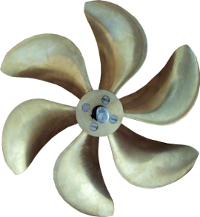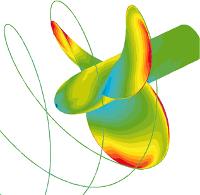Rolla SP Propellers
Via Roncaglia 6
6883 Novazzano - Switzerland

TEL:+41916952000
FAX:+41916952001
Fully submerged propellers are manufactured in NiBrAl up to 3 m diameter with a power range from 600 Hp up to 5000 Hp.
Propellers are designed with a computer panel code method allowing the entire 3-D study and optimization of the geometry.
To properly interface the propeller with its application the hull lines of any design of particular importance can be preliminarily analyzed to predict resistance, trim and wake field at the propeller disc.
Once the velocity field on the propeller has been computed, it is used as "inflow" for the design of the propeller with the panel method and CFD (Computed Fluid Dynamics) analysis.
CFD analysis of submerged propellers
Submerged propellers are designed using programs developed in-house and based on the panel method.
Every possible shape is analyzed and the best is used to generate modified versions until the perfect propeller shape is found at the end of the iterative process. The panel method is fast and sufficiently accurate for most conventional propellers, but since it is based on "potential flow theory", the viscous effects are neglected.
As the "roll up" effect of the trailing wake is difficult to be computed due to loaded propellers or because of design conditions every propeller designed with the panel method is retested using CFD code. This allows the propeller load to be fine-tuned (thrust and torque) and cure local flow phenomena (i.e. at the blade-hub junction) which can be detected and corrected.
Almost every submerged propeller is subject to cavitation:
1 - when it is operating in the ships wake
2 - when it is subject to the effect of shaft inclination
For many years, Rolla has been a member of the "Consortium on Cavitation", a team formed by MIT Boston, and transferred to the UT of Austin. The Consortium aims at developing codes that are able to analyze the cavitation on marine propellers.
Rolla has developed a CFD method that is able to solve the Navier-Stokes equations in 2-D (profile) and 3-D (propeller) conditions, also under the condition of non-stationary cavitation.







